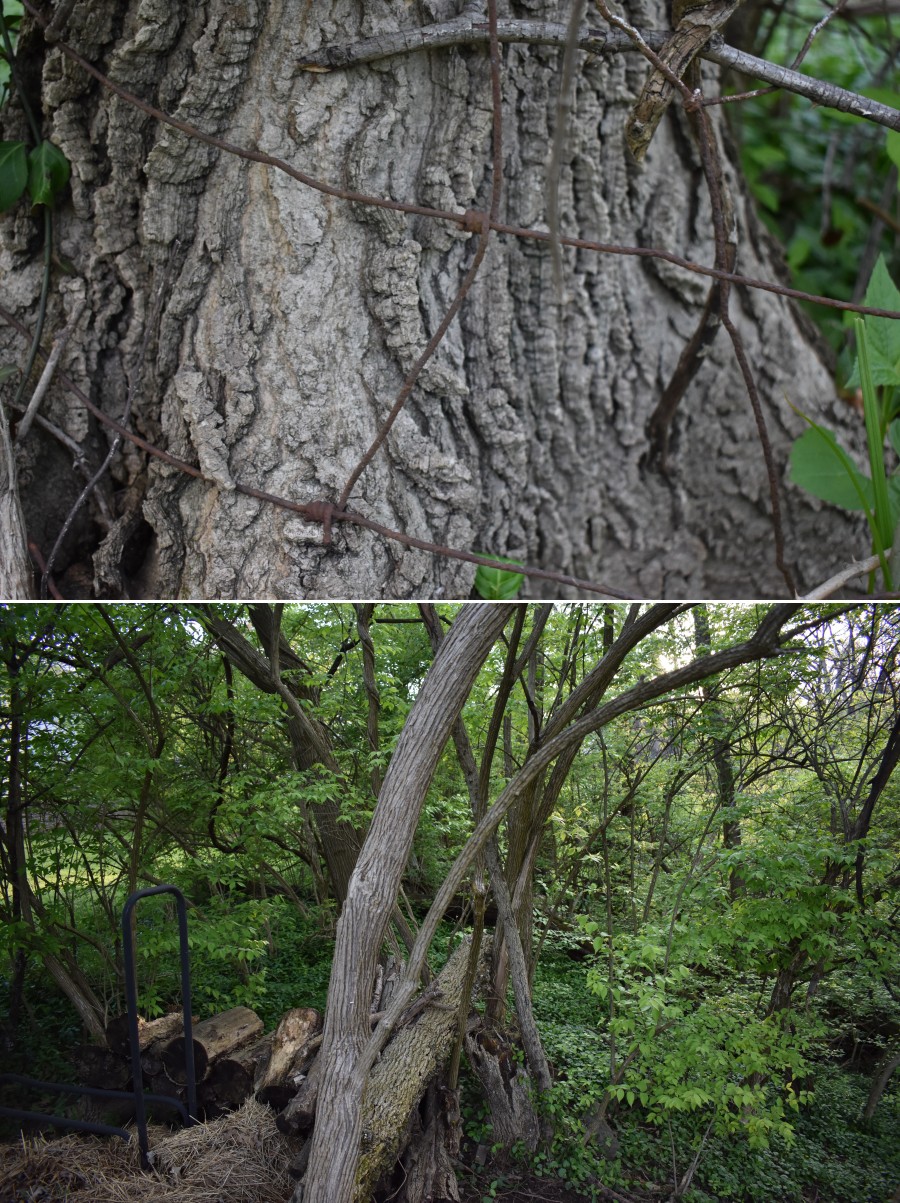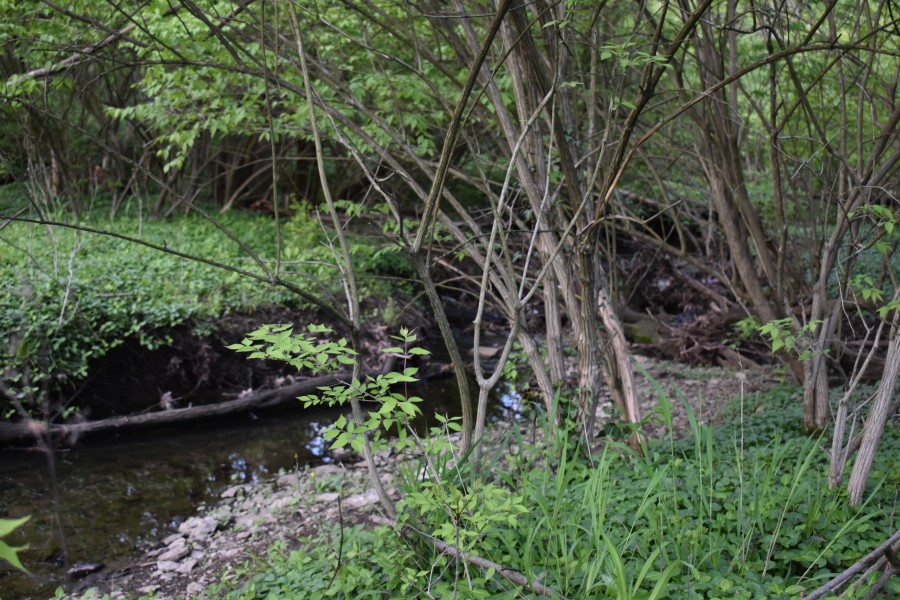Blog
Shaun’s Yard
.jpeg)
A Practical Application of National Wildlife Federation’s Habitat Checklist
by Jason Neumann, Public Programs Manager
Suburban Blue Ash, early April. I had pulled out my lawnmower for the first grass cutting of 2020. Dressed to work in my old yellow Cincinnati Nature Center t-shirt, I pulled the rope on the mower and started making the rounds in the front yard out near the street. A walker caught my eye and stopped me. “You work at the Nature Center? I read your article.” It turns out Shaun is a neighbor from down the street and has been a Nature Center member since 1997. He even volunteered at the Nature Center in the late 90’s.
We spoke about his long history in the neighborhood and his desire to improve his yard in a healthy way. “What’s that? You want to make your yard more like the Nature Center? Sure, I can stop down to look at your yard.” Such an opportune time…I can write a blog post about it.
On the evening of my tour, it quickly became obvious that Shaun had some formative nature experiences in his yard. He grew up there, He said there weren’t that many acres but there was a lot to enjoy. The backyard, which sprawls down into a valley with a small stream, had been a childhood wonderworld where he and his neighborhood friends explored, built forts -- they even built a two-story tree house at one point. They collected rocks and felt they were free to roam “the wilds.”
He later returned to the house to care for his ailing mother. While the front yard is kept tidy, Shaun said most of the backyard hadn’t had much done to it in many years…which made it a place I really wanted to see.
As we walked around the yard, Shaun’s goals emerged:
- Beautify and clean up both the front and back yards in a natural way, without using chemicals.
- Clean up the backyard to make it more usable. He said he might like to run a trail through the “wild” part of his backyard.
- Make the yard more wildlife-friendly and attract more birds.
- Make it look more like the Nature Center, not a golf-course.
- Plant several not-too-big trees in the front yard, at least one of which has springtime flowers.
We started with what’s already there:
Note: any trees and shrubs mentioned are followed for a number – this is the number of known caterpillar species that feed on that plant. Caterpillars are the hotdogs of the bird world (easy to eat tubes of protein) – they’re the primary food that many species of adult birds feed to their young. Check out this list of native caterpillars, moths, and butterflies and their host trees and shrubs at WildOnes.org.
Shaun’s front yard looks like a respectable, well-kept suburban space. A closer at his freshly mown lawn revealed a diversity of plants: violets, dandelion, creeping charlie – all great for pollinators. His family enjoyed a crab apple (308) that was previously in the front yard (but wasn’t so fond of the fruit it dropped on the driveway).
In the bed adjacent to the house, Shaun had multiple pruned boxwoods (introduced), a dwarf spruce (150), daylilies (introduced), a serviceberry bush (124), viburnum (104), Chinese lilac (introduced), a yew (pruned), and catmint.
Heading around the side of the house to the back yard, the wooded hillside behind the house dropped down into a valley with a small stream.

There were multiple hackberry trees (43), several dead ash trees, a black cherry (456) with a wild grape vine (79), a white mulberry (9), in the far back a couple old walnut trees (129). More than 85% of the plant cover was made up of three invasive species: bush honeysuckle formed a sub-canopy creating heavy shade and there was a carpet of winter creeper and lesser celandine underneath. Why are so many invasive plants here? History of the land reveals the reason. Shaun showed me a section of woven wire fence from the pre-1950’s farm on which the subdivision is built – this area was probably grazed by livestock. Shaun also said his family had kept the area mowed and open but it hadn’t been tended in at least 10 years. Invasive plants quickly colonize disturbed ground.

My advice for Shaun was framed around the National Wildlife Federation’s garden certification walk-through checklist:
Sustainable practices: On the checklist, you’ll find this section last. But, because of the conditions in Shaun’s yard, these practices are addressed first.
Control exotic species: remove introduced plants, reduce lawn area
Both bush honeysuckle and winter creeper, the dominant plants in Shaun’s backyard, share a nefarious superpower: they have the ability to chemically elbow out other plants.
Organic practices: eliminate chemical pesticides and fertilizers, use compost
Limit chemical usage – Evidenced by the diversity of plants in Shaun’s front yard, he doesn’t use lawn treatment chemicals (that’s good for wildlife). While there are several non-chemical but laborious ways to control bush honeysuckle and winter creeper, applying the right amount of herbicide at the right time can be like chemotherapy for the land. Without treatment, bush honeysuckle will vigorously re-sprout like a Hydra head.
Soil and water conservation: limit water use, reduce erosion, use mulch
Soil conservation – When removing invasive plants, the soil can be laid bare, making it prone to erosion which is a particular risk on slopes like Shaun’s hillside. A good approach would be to have a plan to remove invasives in stages and have shrubs and other plants ready for planting to help reduce erosion. Mulch placed around new plantings helps reduce erosion and controls weeds.
Food: Plants or supplemental feeders. Seeds from a plant, berries, fruits, pollen, bird feeders.
In the front yard, there’s the opportunity to diversify wildflowers, shooting for season-long bloom. That small flowering tree Shaun hoped for? A redbud, flowering dogwood, or small-fruited crabapple would fit the bill.
In the rear yard, shrubs will help Shaun reach his goal to “make the yard more wildlife-friendly and attract more birds.” Many plants and shrubs even serve quadruple-duty, offering nectar from flowers, producing seeds or fruits, and creating cover and nesting sites. To name a few native options:
- Button bush (19)
- Witch-hazel (63)
- Dogwoods (118) – silky or gray
- Spicebush (11)
- Pawpaw (12)
- Willow (455)
- Elderberry (42)
- Buckeye (33)
- Sassafras (38)
- Nine bark (41)
- Persimmon (46)
Water: A source of clean water for wildlife to drink and bathe such as birdbaths, pond, water gardens, etc.
Big checkmark here as there’s a stream running through the property. Shaun does have a birdbath close to the house to enjoy watching birds up close.
Cover: Places where wildlife can find shelter from the weather and predators
It’s great that Shaun already has some older trees. By planting a variety of native shrubs and creating brush piles out of the bush honeysuckle that’s cut, Shaun can offer a lot of cover for birds and other wildlife. There’s also an opportunity to “leave the leaves” to establish no mow zones where insects find cover over the winter.
Places to raise young: Places for wildlife to engage in courtship behavior, mate and then bear and raise their young. Examples: mature tree, nesting box, dead tree or snag, dense shrubs, host plants for caterpillars
Incorporating a number of shrubs will create many places to raise young. Creating brush piles, and retaining a few snags (standing dead trees) and downed trees will also create nesting options on site.
Don’t forget about host plants, those plants that caterpillars of butterflies and moths eat. In addition to milkweeds, both goldenrods (122) and asters (102) are caterpillar-feeding powerhouses.
Overarching principles to keep in mind
- It’s all about plants -- floral diversity attracts faunal diversity. A broad array of plant species brings in a range of wildlife.
- Choose the right plant for the right place: while it’s tempting to choose a plant because of its attractiveness, that plant won’t thrive if it’s not in the right conditions (soil moisture, light level, etc.)
- Plant a season-long sequence of bloom (interest for us, nectar for insects).
- Maximize the edge between woods and the back lawn. A lot of feeding, nesting and growth happens on the edge.
- Maximize sunlight by creating layers of vegetation as in a forest; plant shrubs under trees and wildflowers under shrubs.
- Use plants, such as shrubs, to solve problems, such as soil erosion or privacy screening.
- While native plants are tough once established, they need watering for the first year. Caging any new plantings is advisable to prevent deer browsing and antler rubbing and munching by rabbits.
Shaun realizes this project will take work and he’s looking to develop a three year plan and possibly hire out some of the work. His effort will beautify his yard and provide satisfaction as he helps a whole lot of wildlife.